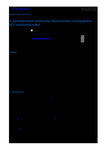A sparsity-based method for fault-tolerant manipulation of a redundant robot
| dc.contributor.author | Li, Z | en |
| dc.contributor.author | Li, C | en |
| dc.contributor.author | Li, S | en |
| dc.contributor.author | Zhu, S | en |
| dc.contributor.author | Samani, H | en |
| dc.date.accessioned | 2022-03-09T00:05:46Z | |
| dc.date.available | 2022-03-09T00:05:46Z | |
| dc.date.issued | 2022-01-01 | en |
| dc.identifier.issn | 0263-5747 | en |
| dc.identifier.uri | http://hdl.handle.net/10026.1/18923 | |
| dc.description.abstract |
As an important part of the manufacturing industry, redundant robots can undertake heavy and tough tasks, which human operators are difficult to sustain. Such onerous and repetitive industrial manipulations, that is, positioning and carrying, impose heavy burdens on the load bearing for redundancy robots' joints. Under the circumstances of long-term and intense industrial operations, joints of redundant robots are conceivably to fall into functional failure, which may possibly cause abrupt joint lock or freeze at unknown time instants. Therefore, task accuracy by end-effectors tends to diminish considerably and gradually because of broken-down joints. In this paper, a sparsity-based method for fault-tolerant motion planning of redundant robots is provided for the first time. The developed fault-tolerant redundancy resolution approach is defined as L1-norm based optimization with immediate variables involved to avoid discontinuity in the dynamic solution process. Meanwhile, those potential faulty joint(s) can be located by the designed fault observer with the proposed fault-diagnosis algorithm. The proposed fault-tolerant motion planning method with fault diagnosis is dynamically optimized by resultant primal dual neural networks with provable convergence. Moreover, the sparsity of joint actuation by the proposed method can be enhanced by around 43.87% and 36.51%, respectively, for tracking circle and square paths. Simulation and experimental findings on a redundant robot (KUKA iiwa) prove the efficacy of the developed defect tolerant approach based on sparsity. | en |
| dc.language.iso | en | en |
| dc.title | A sparsity-based method for fault-tolerant manipulation of a redundant robot | en |
| dc.type | Journal Article | |
| plymouth.publication-status | Published | en |
| plymouth.journal | Robotica | en |
| dc.identifier.doi | 10.1017/S0263574722000285 | en |
| plymouth.organisational-group | /Plymouth | |
| plymouth.organisational-group | /Plymouth/Faculty of Science and Engineering | |
| plymouth.organisational-group | /Plymouth/Faculty of Science and Engineering/School of Engineering, Computing and Mathematics | |
| plymouth.organisational-group | /Plymouth/REF 2021 Researchers by UoA | |
| plymouth.organisational-group | /Plymouth/REF 2021 Researchers by UoA/UoA11 Computer Science and Informatics | |
| plymouth.organisational-group | /Plymouth/Users by role | |
| plymouth.organisational-group | /Plymouth/Users by role/Academics | |
| dc.identifier.eissn | 1469-8668 | en |
| dc.rights.embargoperiod | Not known | en |
| rioxxterms.versionofrecord | 10.1017/S0263574722000285 | en |
| rioxxterms.licenseref.uri | http://www.rioxx.net/licenses/all-rights-reserved | en |
| rioxxterms.type | Journal Article/Review | en |


